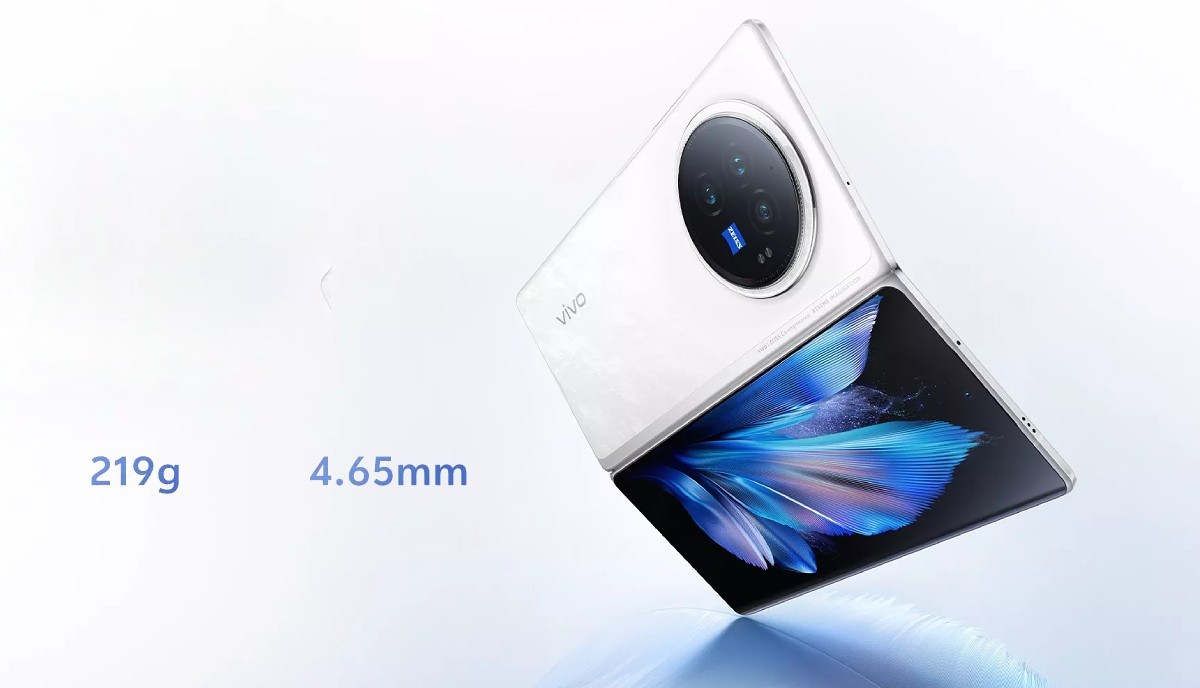
Better, faster, stronger – and thinner and lighter to boot. vivo’s new X Fold3 series significantly slims down the design of the 2023 model (the vivo X Fold2), while also bringing significant improvements to the camera and battery. And yes, it’s a series with vanilla and Pro models.
The vivo X Fold3 weighs just 219g, making it the lightest horizontal inward foldable phone (the Honor V Purse is lighter at 214g, but folds outwards and doesn’t have a second display). This is lighter than many bar phones, e.g. the iPhone 15 Pro Max (221g), Galaxy S24 Ultra (232g) and foldables like the Galaxy Z Fold5 (253g). The X Fold2 itself was quite massive at 279g and 12.9mm when folded. The X Fold3 drops that down to 10.2mm.

Both phones have the same set of displays. The inner panel is 8.03” in diagonal with 2,480 x 2,200px resolution and 120Hz refresh rate. The Samsung E7 material can be pushed to 4,500nits of local peak brightness. The cover display is 6.53” with 1,172 x 2,748px resolution and 120Hz refresh rate, this one uses Q9 Plus material but also boosts to 4,500 nits. That’s more than double the X Fold2 displays that topped out at 1,800 nits and 1,600 nits.

The vivo X Fold3 Pro is powered by the new Snapdragon 8 Gen 3 chipset, paired with the custom vivo V3 imaging chip. It comes in two configurations, 16GB/512GB and 16GB/1TB, with LPDDR5X RAM and UFS 4.0 storage.

Snapdragon 8 Gen 3 for the X Fold3 Pro and 8 Gen 2 for the X Fold3
The imaging chip tackles data from the 50MP “ultra-sensing” main camera, which is equipped with a 1/1.3” OmniVision OV50H sensor and an f/1.68 lens with OIS. This sensor is bigger than the 1/1.49” Sony IMX866v that was in the X Fold2 and adds a bit of weight.
Joining the main camera is a 64MP 3x telephoto module with an OV64B sensor (1/2”) and an f/2.57 lens, plus a 50MP ultra wide-angle (119°) module with a Samsung JN1 (1/2.76”). The selfie cameras use a pair of 32MP sensors (1/3.6”).

The vivo X Fold3 Pro has a larger main sensor and a better tele camera
The vanilla X Fold3 uses the same Snapdragon 8 Gen 2 as the X Fold2. It can be configured from 12GB/256GB to 16GB/1TB (LPDDR5X, UFS 4.0). The V3 imaging chip is missing from this model.
The main camera here uses a 50MP 1/1.49” Sony sensor (an IMX920 this time) and an f/1.75 lens with OIS. There’s also a 50MP 50mm portrait camera (1/2.93” IMX816, f/1.85) and a 50MP ultra wide (the same JN1 with a 119° f/1.85 lens). The selfie cameras are the same 32MP units.
Both X Fold3 models feature a lightweight carbon fiber hinge that weighs only 14.98g. It was certified to withstand 500,000 folds by TÜV Rhinenland. vivo shored up the drop resistance of the phones too – the front is 11 times more resistant, the back 15 times (compared to the X Fold2). Even the foldable display features an impact-resistant film in addition to the UTG.
Here the phones diverge slightly – the Pro model has superior IPX8 water resistance, while the vanilla model only gets IPX4. The X Fold2 had no IP rating at all, so it’s an upgrade in both cases.

The Pro model has IPX8 water resistance, the vanilla phone gets IPX4
The Pro model also stands out with a huge battery – 5,700mAh, that’s 900mAh larger than the X Fold2 battery. The vanilla X Fold3 has a slightly smaller 5,500mAh battery, which probably helps shave off a few grams compared to the Pro.
The Pro battery comes with pro charging of 100W wired and 50W wireless, while its sibling supports 80W wired-only charging.
Both phones boast dual-SIM 5G connectivity, Wi-Fi 7, NFC and an IR blaster. The Pro also gets USB 3.2 Gen2. Both have stereo speakers and Wireless Lossless Hi-Fi audio. And both have physical Mute switches. Besides the better USB, the Pro model also features two 3D ultrasonic fingerprint readers (one under each display), while the vanilla X Fold uses a side-mounted reader.


vivo X Fold3 and X Fold3 Pro highlights
The touch controllers for the both display and the audio amps come from Goodix. The controllers can sense even wet fingers (handy with the new water resistance rating). The SpeakerBoost 5.0 amps are optimized for sound performance on a low voltage (so they use less power).
The vivo X Fold3 starts at CNY 7,000 for the 12GB/256GB model, that converts to $970/€895/₹80,800. There are other options: 16GB/256GB for CNY 7,500, 16GB/512GB for CNY 8,000 and 16GB/1TB for CNY 9,000. Both phones are available in black and white (dubbed “Eclipse Black” and “Solar White”).
The vivo X Fold3 Pro starts at CNY 10,000, this is for a 16GB/512GB phone ($1,385/€1,275/₹117,00). The top of the line model is 16GB/1TB and costs CNY 11,000. The phones are already up on vivo’s store in China and will start shipping by the end of the month. there’s no word on global availability just yet.












